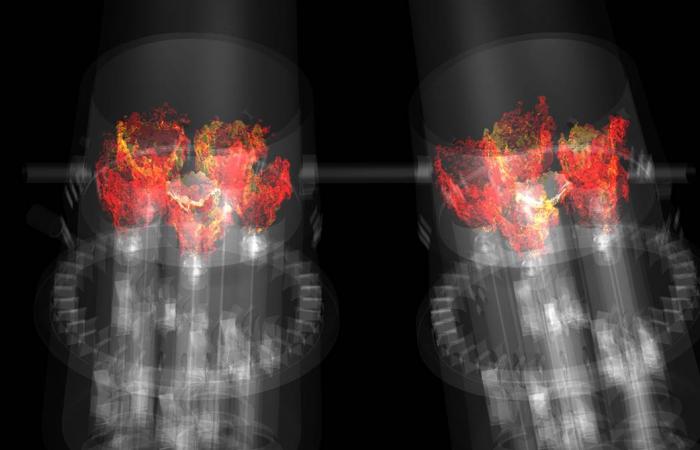Advanced simulation on Titan contributes to breakthrough efficiency gains
October 12, 2017– In 2017, US-based General Electric (GE) delivered its newest heavy-duty gas turbine, the 7HA.02, to two power plants in Texas. The installations marked a milestone in natural gas–derived electricity generation, setting new marks in efficiency and emissions for utility-scale turbomachinery.
A key ingredient in GE’s successful recipe for this breakthrough technology was the ability to conduct critical modeling and simulation on the Titan supercomputer, a leadership-class system managed by the Oak Ridge Leadership Computing Facility (OLCF), a US Department of Energy (DOE) Office of Science User Facility at DOE’s Oak Ridge National Laboratory.
In 2015, GE researchers—in collaboration with software company Cascade Technologies—used Titan to investigate an unexpected combustion instability that had been revealed during tests of a GE gas turbine 1 year earlier. Although GE had determined that instability would not affect gas turbine performance, the company wanted to understand its cause and whether it would manifest in a new gas turbine design.
A concern was that the instability might be excited and increase amplitude with axial fuel staging (AFS). Developed with DOE support, AFS enabled turbine operation at higher temperatures with lower emissions. It accomplished this by introducing a second fuel injection stage into the turbine’s combustion system at a point later than the current industry standard.
“To help meet our deadlines, we wanted to see if we could reproduce the instability numerically,” said Joe Citeno, GE Power combustion engineering manager. “But we didn’t have a predictive model or the internal computational horsepower needed to run it.”
The Cascade team, in partnership with GE, created a groundbreaking high-fidelity model on Titan to examine combustion physics at unprecedented resolution. The team successfully reproduced the instability numerically on Titan and then predicted it would not affect performance in the new 7HA.02 gas turbine design. Physical experiments later confirmed the prediction, validating that the combined GE–Cascade team had created a powerful advanced modeling approach that can predict a range of combustion performance variables for GE’s gas turbine combustor designs, including air-fuel mixing, flame stability, emissions, and exit temperatures.
“The availability of the Titan supercomputer enabled a breakthrough that otherwise would have remained unrealized,” Citeno said. The new 7HA.02 gas turbine was put into production on schedule, and the first systems were successfully installed in Texas in the spring of 2017.
Now, GE is busy fulfilling orders for this new turbine, which can achieve an overall efficiency of more than 62 percent in a combined-cycle plant; it is projected to exceed world-record efficiency marks set by GE’s 9HA turbine model. “For our customers, that means lower fuel consumption and reduced cost per megawatt,” Citeno said.
The 7HA.02 installations are more than 2 percent higher than previous 7F-class gas turbines in combined cycle efficiency. This improvement may seem small, but even a small change can produce an enormous impact. For example, just a 1 percent efficiency gain applied across the entire US combined-cycle fleet would save an estimated $11 billion or more in fuel over the next 20 years.
At the Texas plants, the new turbines can respond quickly to fluctuating power demands, filling a critical role in the state’s energy portfolio. During periods of high demand, the plants can provide power for more than 2 million homes.
Building on its simulation success and still working with Cascade, GE continues to use advanced software and its own high-performance computers to evaluate new product designs and test the limits of modern engineering—meaning high-performance computing will likely play a major role in the next leap forward in combustion systems.
“It’s enabling us to be more confident in the moves we make to increase efficiency and product flexibility,” Citeno said.
The OLCF is a DOE Office of Science User Facility located at Oak Ridge National Laboratory. Oak Ridge National Laboratory is supported by the US Department of Energy’s Office of Science. The single largest supporter of basic research in the physical sciences in the United States, the Office of Science is working to address some of the most pressing challenges of our time. For more information, please visit energy.gov/science.


